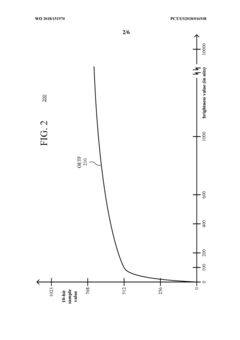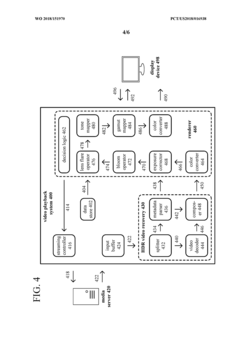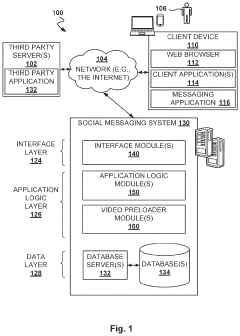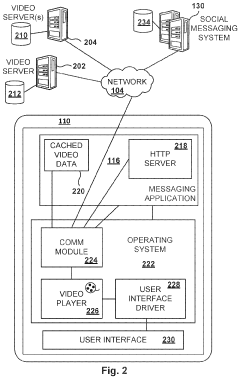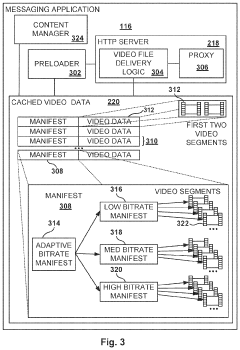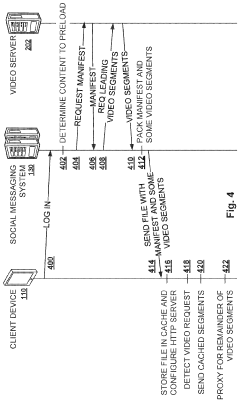Optimizing Video Streaming Protocols Using Dolby Vision
JUL 30, 20259 MIN READ
Generate Your Research Report Instantly with AI Agent
Patsnap Eureka helps you evaluate technical feasibility & market potential.
Dolby Vision Streaming Evolution and Objectives
Dolby Vision, introduced in 2014, has revolutionized the video streaming landscape by offering superior High Dynamic Range (HDR) and Wide Color Gamut (WCG) capabilities. The technology's evolution has been driven by the increasing demand for high-quality visual experiences across various devices and platforms. Initially focused on cinema and high-end televisions, Dolby Vision has expanded its reach to mobile devices, tablets, and streaming services, adapting to the changing consumption patterns of digital content.
The primary objective of Dolby Vision in video streaming is to deliver a consistent, high-quality viewing experience that closely matches the creator's intent across diverse display technologies. This involves optimizing the encoding, transmission, and decoding processes to maintain the integrity of HDR and WCG data while managing bandwidth constraints. As streaming services proliferate and consumer expectations rise, Dolby Vision aims to become the de facto standard for premium video content delivery.
Another key goal is to enhance the efficiency of video streaming protocols to reduce latency and bandwidth requirements without compromising visual quality. This is particularly crucial in the context of live streaming and interactive content, where real-time performance is essential. Dolby Vision's evolution also focuses on improving compatibility with a wide range of devices, ensuring that viewers can enjoy enhanced visual experiences regardless of their hardware specifications.
The technology's development trajectory includes expanding support for emerging display technologies, such as microLED and OLED, which offer even greater potential for HDR reproduction. Additionally, Dolby Vision is evolving to accommodate higher frame rates and resolutions, anticipating the future needs of 8K content and beyond. This forward-looking approach aims to future-proof the technology and maintain its relevance in the rapidly advancing field of digital video.
Integrating artificial intelligence and machine learning into the Dolby Vision ecosystem is another significant objective. These technologies can potentially optimize encoding parameters in real-time, adapt to network conditions, and even enhance legacy content to near-HDR quality. By leveraging AI, Dolby Vision seeks to provide a more adaptive and intelligent streaming solution that can dynamically adjust to varying content types and viewing environments.
The primary objective of Dolby Vision in video streaming is to deliver a consistent, high-quality viewing experience that closely matches the creator's intent across diverse display technologies. This involves optimizing the encoding, transmission, and decoding processes to maintain the integrity of HDR and WCG data while managing bandwidth constraints. As streaming services proliferate and consumer expectations rise, Dolby Vision aims to become the de facto standard for premium video content delivery.
Another key goal is to enhance the efficiency of video streaming protocols to reduce latency and bandwidth requirements without compromising visual quality. This is particularly crucial in the context of live streaming and interactive content, where real-time performance is essential. Dolby Vision's evolution also focuses on improving compatibility with a wide range of devices, ensuring that viewers can enjoy enhanced visual experiences regardless of their hardware specifications.
The technology's development trajectory includes expanding support for emerging display technologies, such as microLED and OLED, which offer even greater potential for HDR reproduction. Additionally, Dolby Vision is evolving to accommodate higher frame rates and resolutions, anticipating the future needs of 8K content and beyond. This forward-looking approach aims to future-proof the technology and maintain its relevance in the rapidly advancing field of digital video.
Integrating artificial intelligence and machine learning into the Dolby Vision ecosystem is another significant objective. These technologies can potentially optimize encoding parameters in real-time, adapt to network conditions, and even enhance legacy content to near-HDR quality. By leveraging AI, Dolby Vision seeks to provide a more adaptive and intelligent streaming solution that can dynamically adjust to varying content types and viewing environments.
Market Demand for High-Quality Video Streaming
The demand for high-quality video streaming has experienced exponential growth in recent years, driven by advancements in display technologies, increased internet bandwidth, and changing consumer preferences. As viewers become more discerning, there is a growing expectation for superior visual experiences across various devices and platforms.
The market for premium video content, particularly those enhanced with Dolby Vision technology, has seen significant expansion. Streaming giants like Netflix, Amazon Prime Video, and Disney+ have invested heavily in Dolby Vision-enabled content to differentiate their offerings and attract subscribers. This trend is further amplified by the proliferation of 4K and HDR-capable devices in households worldwide.
Consumer surveys indicate a strong willingness to pay for enhanced video quality. A recent study revealed that over 70% of streaming service subscribers consider video quality as a crucial factor in their choice of platform. Furthermore, viewers who experience Dolby Vision content report higher satisfaction rates and increased engagement times compared to standard video formats.
The COVID-19 pandemic has accelerated the shift towards home entertainment, further boosting the demand for premium streaming experiences. With cinemas closed and people spending more time at home, there has been a surge in the consumption of high-quality video content. This behavioral change is expected to have lasting effects on consumer preferences even post-pandemic.
The gaming industry has also contributed to the growing demand for high-quality video streaming. With the rise of cloud gaming services and game streaming platforms, there is an increasing need for low-latency, high-fidelity video transmission to ensure seamless gameplay experiences.
From a technological standpoint, the adoption of 5G networks is set to revolutionize video streaming capabilities. The increased bandwidth and reduced latency offered by 5G will enable more widespread access to high-quality video content, including Dolby Vision-enhanced streams, on mobile devices.
However, challenges remain in delivering consistent high-quality video experiences across diverse network conditions and devices. This creates a significant market opportunity for optimized video streaming protocols that can adapt to varying bandwidth constraints while maintaining visual fidelity.
As the ecosystem of smart TVs, tablets, and smartphones continues to expand, there is a growing need for standardized protocols that can ensure optimal playback of Dolby Vision content across different platforms. This interoperability is crucial for content creators and streaming services to maximize their reach and return on investment in premium video production.
The market for premium video content, particularly those enhanced with Dolby Vision technology, has seen significant expansion. Streaming giants like Netflix, Amazon Prime Video, and Disney+ have invested heavily in Dolby Vision-enabled content to differentiate their offerings and attract subscribers. This trend is further amplified by the proliferation of 4K and HDR-capable devices in households worldwide.
Consumer surveys indicate a strong willingness to pay for enhanced video quality. A recent study revealed that over 70% of streaming service subscribers consider video quality as a crucial factor in their choice of platform. Furthermore, viewers who experience Dolby Vision content report higher satisfaction rates and increased engagement times compared to standard video formats.
The COVID-19 pandemic has accelerated the shift towards home entertainment, further boosting the demand for premium streaming experiences. With cinemas closed and people spending more time at home, there has been a surge in the consumption of high-quality video content. This behavioral change is expected to have lasting effects on consumer preferences even post-pandemic.
The gaming industry has also contributed to the growing demand for high-quality video streaming. With the rise of cloud gaming services and game streaming platforms, there is an increasing need for low-latency, high-fidelity video transmission to ensure seamless gameplay experiences.
From a technological standpoint, the adoption of 5G networks is set to revolutionize video streaming capabilities. The increased bandwidth and reduced latency offered by 5G will enable more widespread access to high-quality video content, including Dolby Vision-enhanced streams, on mobile devices.
However, challenges remain in delivering consistent high-quality video experiences across diverse network conditions and devices. This creates a significant market opportunity for optimized video streaming protocols that can adapt to varying bandwidth constraints while maintaining visual fidelity.
As the ecosystem of smart TVs, tablets, and smartphones continues to expand, there is a growing need for standardized protocols that can ensure optimal playback of Dolby Vision content across different platforms. This interoperability is crucial for content creators and streaming services to maximize their reach and return on investment in premium video production.
Current Challenges in Dolby Vision Streaming
Despite the significant advancements in Dolby Vision technology, several challenges persist in optimizing video streaming protocols for this high-dynamic-range (HDR) format. One of the primary issues is the increased bandwidth requirement for Dolby Vision content. The enhanced color depth and dynamic metadata associated with Dolby Vision streams necessitate higher bitrates, which can strain network infrastructure and impact streaming quality, especially in areas with limited internet connectivity.
Another challenge lies in the complexity of implementing Dolby Vision across diverse devices and platforms. The technology requires specific hardware and software support, which is not universally available. This fragmentation in the ecosystem creates difficulties for content providers and streaming services in ensuring a consistent viewing experience across all devices, from high-end televisions to mobile phones.
Latency is a critical concern in live streaming scenarios involving Dolby Vision. The additional processing required for HDR content can introduce delays, potentially disrupting the real-time nature of live events. Balancing the need for high-quality visuals with minimal latency remains a significant technical hurdle.
Content creation and encoding for Dolby Vision also present challenges. The process of mastering content in Dolby Vision format is more complex and time-consuming compared to standard dynamic range (SDR) content. This complexity extends to the encoding process, where optimizing for various streaming scenarios while maintaining the visual integrity of Dolby Vision can be technically demanding.
Adaptive bitrate streaming, a crucial technique for smooth playback across varying network conditions, faces unique challenges with Dolby Vision content. Developing efficient algorithms that can dynamically adjust the stream quality while preserving the HDR characteristics of Dolby Vision is an ongoing area of research and development.
Compatibility with existing content delivery networks (CDNs) and streaming infrastructures is another significant challenge. Many current systems are not optimized for the specific requirements of Dolby Vision streams, potentially leading to inefficiencies in content delivery and increased costs for streaming providers.
Lastly, the challenge of standardization and interoperability remains. While Dolby Vision has gained significant traction, it competes with other HDR formats like HDR10+. This fragmentation in the HDR landscape complicates the development of universally compatible streaming protocols and increases the complexity for both content creators and streaming platforms.
Another challenge lies in the complexity of implementing Dolby Vision across diverse devices and platforms. The technology requires specific hardware and software support, which is not universally available. This fragmentation in the ecosystem creates difficulties for content providers and streaming services in ensuring a consistent viewing experience across all devices, from high-end televisions to mobile phones.
Latency is a critical concern in live streaming scenarios involving Dolby Vision. The additional processing required for HDR content can introduce delays, potentially disrupting the real-time nature of live events. Balancing the need for high-quality visuals with minimal latency remains a significant technical hurdle.
Content creation and encoding for Dolby Vision also present challenges. The process of mastering content in Dolby Vision format is more complex and time-consuming compared to standard dynamic range (SDR) content. This complexity extends to the encoding process, where optimizing for various streaming scenarios while maintaining the visual integrity of Dolby Vision can be technically demanding.
Adaptive bitrate streaming, a crucial technique for smooth playback across varying network conditions, faces unique challenges with Dolby Vision content. Developing efficient algorithms that can dynamically adjust the stream quality while preserving the HDR characteristics of Dolby Vision is an ongoing area of research and development.
Compatibility with existing content delivery networks (CDNs) and streaming infrastructures is another significant challenge. Many current systems are not optimized for the specific requirements of Dolby Vision streams, potentially leading to inefficiencies in content delivery and increased costs for streaming providers.
Lastly, the challenge of standardization and interoperability remains. While Dolby Vision has gained significant traction, it competes with other HDR formats like HDR10+. This fragmentation in the HDR landscape complicates the development of universally compatible streaming protocols and increases the complexity for both content creators and streaming platforms.
Existing Dolby Vision Streaming Solutions
01 Adaptive bitrate streaming for video quality optimization
Adaptive bitrate streaming techniques are used to dynamically adjust video quality based on network conditions and device capabilities. This approach involves encoding video content at multiple bitrates and resolutions, allowing the streaming system to switch between different quality levels in real-time to maintain smooth playback and optimize video quality.- Adaptive bitrate streaming: This technique dynamically adjusts video quality based on network conditions and device capabilities. It involves encoding video at multiple bitrates and resolutions, allowing seamless switching between different quality levels to maintain smooth playback and optimize viewer experience.
- Video quality assessment and enhancement: Methods for analyzing and improving video quality in streaming applications. This includes techniques for real-time quality assessment, artifact detection, and enhancement algorithms to address issues such as compression artifacts, noise, and blur.
- Low-latency streaming protocols: Protocols designed to minimize delay in live video streaming, crucial for interactive applications and live events. These protocols optimize encoding, transmission, and decoding processes to reduce end-to-end latency while maintaining video quality.
- Multi-view video streaming: Techniques for streaming multiple camera views or perspectives of the same scene. This includes methods for efficient encoding, transmission, and client-side rendering of multi-view video content, enabling immersive viewing experiences.
- Content-aware streaming optimization: Approaches that analyze video content to optimize streaming parameters. This includes scene-based encoding, perceptual quality optimization, and content-adaptive streaming strategies to improve overall video quality and efficiency.
02 Video quality assessment and enhancement
Various methods are employed to assess and enhance video quality in streaming protocols. These include analyzing video frames for artifacts, applying machine learning algorithms to predict perceived quality, and implementing real-time enhancement techniques to improve visual fidelity during streaming.Expand Specific Solutions03 Low-latency streaming protocols
Specialized streaming protocols are developed to minimize latency in video delivery while maintaining high quality. These protocols optimize encoding, transmission, and decoding processes to reduce delay between video capture and playback, which is crucial for live streaming and interactive applications.Expand Specific Solutions04 Error resilience and packet loss concealment
Techniques are implemented to improve video quality in the presence of network errors or packet loss. These include forward error correction, retransmission strategies, and advanced packet loss concealment algorithms that can reconstruct missing or corrupted video data to maintain visual quality.Expand Specific Solutions05 Multi-view and 3D video streaming
Protocols and methods are developed for streaming multi-view and 3D video content while maintaining high quality. These approaches address the challenges of increased bandwidth requirements, synchronization between views, and optimizing the perception of depth and immersion in 3D video applications.Expand Specific Solutions
Key Players in Dolby Vision Ecosystem
The video streaming protocol optimization landscape using Dolby Vision is in a growth phase, with increasing market size and evolving technological maturity. Major players like Microsoft, Samsung, and Huawei are investing heavily in this area, leveraging their expertise in video processing and display technologies. The market is characterized by intense competition among tech giants and specialized companies like V-Nova International, each striving to develop more efficient and high-quality streaming solutions. As the demand for premium video experiences grows, we're seeing rapid advancements in compression algorithms and adaptive streaming techniques tailored for Dolby Vision content, indicating a dynamic and innovative sector with significant potential for further expansion and refinement.
Samsung Electronics Co., Ltd.
Technical Solution: Samsung has developed a comprehensive video streaming protocol optimized for Dolby Vision, integrated with their Tizen operating system and display technologies. Their approach focuses on end-to-end optimization, from content delivery to display rendering. Samsung's streaming protocol incorporates adaptive bit-rate streaming specifically tuned for Dolby Vision content, ensuring smooth playback across varying network conditions[13]. They have also implemented advanced color management systems that accurately map Dolby Vision's wide color gamut to their QLED and OLED displays, maximizing the visual impact of HDR content[14]. Additionally, Samsung's technology includes AI-powered scene detection that dynamically adjusts streaming parameters based on content type, optimizing both quality and bandwidth usage for Dolby Vision streams[15].
Strengths: Tight integration with Samsung displays, adaptive streaming optimized for Dolby Vision, AI-enhanced content optimization. Weaknesses: Best performance may be limited to Samsung ecosystem, potential compatibility issues with non-Samsung devices.
NVIDIA Corp.
Technical Solution: NVIDIA has developed GPU-accelerated video streaming protocols optimized for Dolby Vision content. Their approach leverages the parallel processing capabilities of GPUs to enhance encoding and decoding efficiency for HDR streams. NVIDIA's technology includes real-time tone mapping that dynamically adjusts Dolby Vision content to match the capabilities of the display device, ensuring optimal visual quality across a wide range of screens[10]. They have also implemented AI-driven upscaling techniques that can enhance the resolution and quality of Dolby Vision content in real-time, allowing for improved streaming experiences even on lower bandwidth connections[11]. Additionally, NVIDIA's streaming protocol incorporates advanced error resilience features to maintain high-quality Dolby Vision playback in challenging network conditions[12].
Strengths: GPU acceleration for efficient processing, AI-enhanced upscaling, robust error resilience. Weaknesses: May require NVIDIA hardware for optimal performance, potential increased power consumption on mobile devices.
Core Innovations in HDR Video Compression
Content mastering with an energy-preserving bloom operator during playback of high dynamic range video
PatentWO2018151970A1
Innovation
- Implementing an energy-preserving bloom operator during playback, which spreads high-intensity values to adjacent areas, allowing for more realistic rendering of bright highlights and retaining details through metadata, along with other content mastering operations like tone mapping and color gamut mapping, tailored to the actual display device and user preferences.
Video streaming optimization for quick start of video display
PatentActiveUS11310300B2
Innovation
- Implementing an embedded HTTP server in the application to preload manifest files and video data, allowing the server to act as a proxy for retrieving files from a remote video server, thereby reducing the initial startup time by caching essential data locally.
Bandwidth and Network Infrastructure Considerations
Optimizing video streaming protocols for Dolby Vision requires careful consideration of bandwidth and network infrastructure. The implementation of Dolby Vision technology in streaming services demands higher bitrates compared to standard dynamic range (SDR) content, necessitating robust network capabilities to ensure smooth playback and optimal viewing experiences.
Bandwidth requirements for Dolby Vision content vary depending on the resolution and frame rate. For 4K HDR content with Dolby Vision, streaming services typically recommend a minimum internet speed of 25 Mbps. However, to accommodate peak bitrates and ensure buffer-free streaming, a connection of 50 Mbps or higher is often recommended. This increased bandwidth demand poses challenges for both content providers and consumers, particularly in regions with limited network infrastructure.
Network infrastructure plays a crucial role in supporting Dolby Vision streaming. Content delivery networks (CDNs) must be optimized to handle the increased data load and ensure efficient distribution of high-quality video streams. Edge caching and intelligent routing algorithms become essential to minimize latency and maintain consistent quality of service across diverse geographic locations.
Adaptive bitrate streaming (ABR) technologies are particularly important when dealing with Dolby Vision content. These systems dynamically adjust video quality based on available bandwidth and network conditions, ensuring that viewers receive the best possible experience without interruptions. For Dolby Vision, ABR algorithms need to be fine-tuned to manage the transition between different quality levels while maintaining the enhanced visual fidelity that Dolby Vision provides.
The implementation of advanced video codecs, such as HEVC (H.265) or the emerging VVC (H.266), is crucial for optimizing Dolby Vision streaming. These codecs offer improved compression efficiency, allowing for the delivery of high-quality HDR content at lower bitrates. However, their adoption requires updates to both server-side encoding infrastructure and client-side decoding capabilities.
Network operators and internet service providers (ISPs) face the challenge of upgrading their infrastructure to support the increased bandwidth demands of Dolby Vision streaming. This may involve investments in fiber-optic networks, 5G technology, and improved last-mile connectivity to ensure that end-users can access high-quality streams without bottlenecks.
As the adoption of Dolby Vision in streaming services grows, it becomes increasingly important to develop and implement efficient traffic management and quality of service (QoS) policies. These policies should prioritize video traffic, especially during peak usage hours, to maintain the integrity of Dolby Vision content delivery without compromising other network services.
Bandwidth requirements for Dolby Vision content vary depending on the resolution and frame rate. For 4K HDR content with Dolby Vision, streaming services typically recommend a minimum internet speed of 25 Mbps. However, to accommodate peak bitrates and ensure buffer-free streaming, a connection of 50 Mbps or higher is often recommended. This increased bandwidth demand poses challenges for both content providers and consumers, particularly in regions with limited network infrastructure.
Network infrastructure plays a crucial role in supporting Dolby Vision streaming. Content delivery networks (CDNs) must be optimized to handle the increased data load and ensure efficient distribution of high-quality video streams. Edge caching and intelligent routing algorithms become essential to minimize latency and maintain consistent quality of service across diverse geographic locations.
Adaptive bitrate streaming (ABR) technologies are particularly important when dealing with Dolby Vision content. These systems dynamically adjust video quality based on available bandwidth and network conditions, ensuring that viewers receive the best possible experience without interruptions. For Dolby Vision, ABR algorithms need to be fine-tuned to manage the transition between different quality levels while maintaining the enhanced visual fidelity that Dolby Vision provides.
The implementation of advanced video codecs, such as HEVC (H.265) or the emerging VVC (H.266), is crucial for optimizing Dolby Vision streaming. These codecs offer improved compression efficiency, allowing for the delivery of high-quality HDR content at lower bitrates. However, their adoption requires updates to both server-side encoding infrastructure and client-side decoding capabilities.
Network operators and internet service providers (ISPs) face the challenge of upgrading their infrastructure to support the increased bandwidth demands of Dolby Vision streaming. This may involve investments in fiber-optic networks, 5G technology, and improved last-mile connectivity to ensure that end-users can access high-quality streams without bottlenecks.
As the adoption of Dolby Vision in streaming services grows, it becomes increasingly important to develop and implement efficient traffic management and quality of service (QoS) policies. These policies should prioritize video traffic, especially during peak usage hours, to maintain the integrity of Dolby Vision content delivery without compromising other network services.
Content Protection and DRM Integration
Content protection and Digital Rights Management (DRM) integration are crucial aspects of optimizing video streaming protocols, especially when dealing with high-quality content like Dolby Vision. As streaming services continue to deliver premium content, ensuring robust security measures becomes paramount to protect intellectual property and maintain the integrity of the streaming ecosystem.
The integration of DRM systems with Dolby Vision-enabled content presents unique challenges due to the advanced nature of the HDR format. Dolby Vision's dynamic metadata and enhanced color depth require specialized encryption methods to maintain the quality of the viewing experience while safeguarding against unauthorized access and piracy.
One of the primary considerations in this integration is the seamless encryption and decryption of Dolby Vision content without compromising its visual fidelity. This involves developing DRM solutions that can handle the additional layers of information present in Dolby Vision streams, including the base layer and enhancement layer data.
Industry-standard DRM technologies such as Widevine, PlayReady, and FairPlay must be adapted to work efficiently with Dolby Vision streams. This adaptation includes ensuring that the DRM systems can process and protect the dynamic metadata associated with Dolby Vision content, which is critical for maintaining the intended visual experience across different display capabilities.
Another key aspect of content protection in this context is the implementation of secure key exchange mechanisms. These mechanisms must be designed to handle the increased data throughput associated with Dolby Vision streams while maintaining low latency to preserve the quality of the streaming experience.
The integration of watermarking technologies specifically tailored for Dolby Vision content is also an important consideration. These watermarks need to be imperceptible to viewers but robust enough to survive potential piracy attempts, including screen captures and re-encoding.
Furthermore, the DRM integration must account for the various device ecosystems that support Dolby Vision playback. This includes ensuring compatibility across a wide range of smart TVs, mobile devices, and streaming boxes, each with its own hardware capabilities and security features.
Optimizing the DRM workflow for Dolby Vision content also involves minimizing the computational overhead introduced by content protection measures. This is particularly important for maintaining smooth playback and quick start times, which are critical factors in user experience and engagement with streaming platforms.
In conclusion, the successful integration of content protection and DRM systems with Dolby Vision-optimized streaming protocols requires a multifaceted approach. It demands a delicate balance between robust security measures and the preservation of the high-quality viewing experience that Dolby Vision provides. As the streaming landscape continues to evolve, ongoing research and development in this area will be essential to stay ahead of potential security threats while delivering cutting-edge visual experiences to consumers.
The integration of DRM systems with Dolby Vision-enabled content presents unique challenges due to the advanced nature of the HDR format. Dolby Vision's dynamic metadata and enhanced color depth require specialized encryption methods to maintain the quality of the viewing experience while safeguarding against unauthorized access and piracy.
One of the primary considerations in this integration is the seamless encryption and decryption of Dolby Vision content without compromising its visual fidelity. This involves developing DRM solutions that can handle the additional layers of information present in Dolby Vision streams, including the base layer and enhancement layer data.
Industry-standard DRM technologies such as Widevine, PlayReady, and FairPlay must be adapted to work efficiently with Dolby Vision streams. This adaptation includes ensuring that the DRM systems can process and protect the dynamic metadata associated with Dolby Vision content, which is critical for maintaining the intended visual experience across different display capabilities.
Another key aspect of content protection in this context is the implementation of secure key exchange mechanisms. These mechanisms must be designed to handle the increased data throughput associated with Dolby Vision streams while maintaining low latency to preserve the quality of the streaming experience.
The integration of watermarking technologies specifically tailored for Dolby Vision content is also an important consideration. These watermarks need to be imperceptible to viewers but robust enough to survive potential piracy attempts, including screen captures and re-encoding.
Furthermore, the DRM integration must account for the various device ecosystems that support Dolby Vision playback. This includes ensuring compatibility across a wide range of smart TVs, mobile devices, and streaming boxes, each with its own hardware capabilities and security features.
Optimizing the DRM workflow for Dolby Vision content also involves minimizing the computational overhead introduced by content protection measures. This is particularly important for maintaining smooth playback and quick start times, which are critical factors in user experience and engagement with streaming platforms.
In conclusion, the successful integration of content protection and DRM systems with Dolby Vision-optimized streaming protocols requires a multifaceted approach. It demands a delicate balance between robust security measures and the preservation of the high-quality viewing experience that Dolby Vision provides. As the streaming landscape continues to evolve, ongoing research and development in this area will be essential to stay ahead of potential security threats while delivering cutting-edge visual experiences to consumers.
Unlock deeper insights with Patsnap Eureka Quick Research — get a full tech report to explore trends and direct your research. Try now!
Generate Your Research Report Instantly with AI Agent
Supercharge your innovation with Patsnap Eureka AI Agent Platform!

